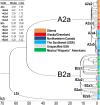Reconciling migration models to the Americas with the variation of North American native mitogenomes
- PMID: 23940335
- PMCID: PMC3761611
- DOI: 10.1073/pnas.1306290110
Reconciling migration models to the Americas with the variation of North American native mitogenomes
Abstract
In this study we evaluated migration models to the Americas by using the information contained in native mitochondrial genomes (mitogenomes) from North America. Molecular and phylogeographic analyses of B2a mitogenomes, which are absent in Eskimo-Aleut and northern Na-Dene speakers, revealed that this haplogroup arose in North America ∼11-13 ka from one of the founder Paleo-Indian B2 mitogenomes. In contrast, haplogroup A2a, which is typical of Eskimo-Aleuts and Na-Dene, but also present in the easternmost Siberian groups, originated only 4-7 ka in Alaska, led to the first Paleo-Eskimo settlement of northern Canada and Greenland, and contributed to the formation of the Na-Dene gene pool. However, mitogenomes also show that Amerindians from northern North America, without any distinction between Na-Dene and non-Na-Dene, were heavily affected by an additional and distinctive Beringian genetic input. In conclusion, most mtDNA variation (along the double-continent) stems from the first wave from Beringia, which followed the Pacific coastal route. This was accompanied or followed by a second inland migratory event, marked by haplogroups X2a and C4c, which affected all Amerindian groups of Northern North America. Much later, the ancestral A2a carriers spread from Alaska, undertaking both a westward migration to Asia and an eastward expansion into the circumpolar regions of Canada. Thus, the first American founders left the greatest genetic mark but the original maternal makeup of North American Natives was subsequently reshaped by additional streams of gene flow and local population dynamics, making a three-wave view too simplistic.
Keywords: Native Americans; human mtDNA.
Conflict of interest statement
The authors declare no conflict of interest.
Figures




Comment in
-
Reconciling pre-Columbian settlement hypotheses requires integrative, multidisciplinary, and model-bound approaches.Proc Natl Acad Sci U S A. 2014 Jan 14;111(2):E213-4. doi: 10.1073/pnas.1321197111. Epub 2014 Jan 7. Proc Natl Acad Sci U S A. 2014. PMID: 24398530 Free PMC article. No abstract available.
References
-
- Curry A. Ancient migration: Coming to America. Nature. 2012;485(7396):30–32. - PubMed
-
- Goebel T, Waters MR, O’Rourke DH. The late Pleistocene dispersal of modern humans in the Americas. Science. 2008;319(5869):1497–1502. - PubMed
-
- Mazières S. Towards a reconciling model about the initial peopling of America. C R Biol. 2011;334(7):497–504. - PubMed
-
- Schurr TG, Sherry ST. Mitochondrial DNA and Y chromosome diversity and the peopling of the Americas: Evolutionary and demographic evidence. Am J Hum Biol. 2004;16(4):420–439. - PubMed
Publication types
MeSH terms
Associated data
- Actions
- Actions
- Actions
- Actions
- Actions
- Actions
- Actions
- Actions
- Actions
- Actions
- Actions
- Actions
- Actions
- Actions
- Actions
- Actions
- Actions
- Actions
- Actions
- Actions
- Actions
- Actions
- Actions
- Actions
- Actions
- Actions
- Actions
- Actions
- Actions
- Actions
- Actions
- Actions
- Actions
- Actions
- Actions
- Actions
- Actions
- Actions
- Actions
- Actions
- Actions
LinkOut - more resources
Full Text Sources
Other Literature Sources

